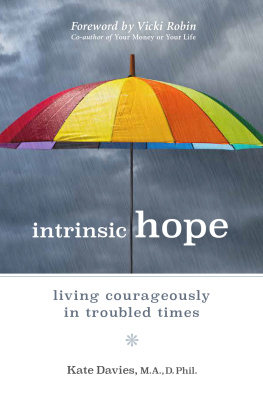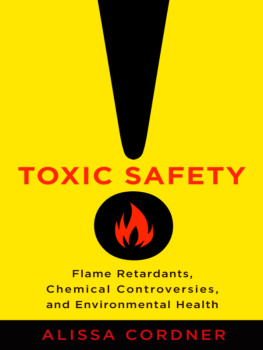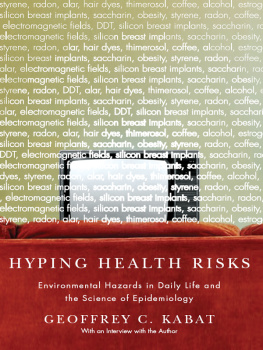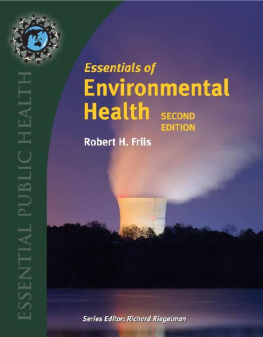The Rise of the U.S. Environmental Health Movement
The Rise of the U.S. Environmental Health Movement
Kate Davies
ROWMAN & LITTLEFIELD PUBLISHERS, INC.
Lanham Boulder New York Toronto Plymouth, UK
Published by Rowman & Littlefield Publishers, Inc.
A wholly owned subsidiary of The Rowman & Littlefield Publishing Group, Inc.
4501 Forbes Boulevard, Suite 200, Lanham, Maryland 20706
www.rowman.com
10 Thornbury Road, Plymouth PL6 7PP, United Kingdom
Copyright 2013 by Rowman & Littlefield Publishers, Inc.
All rights reserved. No part of this book may be reproduced in any form or by any electronic or mechanical means, including information storage and retrieval systems, without written permission from the publisher, except by a reviewer who may quote passages in a review.
British Library Cataloguing in Publication Information Available
Library of Congress Cataloging-in-Publication Data
Davies, Kate, 1956- .
Rise of the U.S. environmental health movement / Kate Davies.
p. cm.
Includes bibliographical references and index.
ISBN 978-1-4422-2137-6 (cloth : alk. paper) ISBN 978-1-4422-2138-3 (electronic)
1. Environmental healthUnited StatesHistory. 2. PollutionEnvironmental aspectsUnited States. 3. EnvironmentalismUnited StatesHistory. I. Title.
RA566.3.D38 2013
613'.1dc23
2013000229
 TM The paper used in this publication meets the minimum requirements of American National Standard for Information Sciences Permanence of Paper for Printed Library Materials, ANSI/NISO Z39.48-1992.
TM The paper used in this publication meets the minimum requirements of American National Standard for Information Sciences Permanence of Paper for Printed Library Materials, ANSI/NISO Z39.48-1992.
Printed in the United States of America
The earth does not belong to man: man belongs to the earth. This we know. All things are connected like the blood, which unites one family. All things are connected. Whatever befalls the earth befalls the sons of the earth. Man did not weave the web of life; he is merely a strand it. Whatever he does to the web, he does to himself. Attributed to Chief Seattle
Foreword
Elise Miller
Every other week my eight-year-old son goes to an after school chemistry club with his buddymeaning they spend an hour with a retired science teacher who is passionate about passing on his knowledge to the next generation. His lab is something out of the early twentieth century, containing rows of dusty bottles with handwritten labels identifying specific chemicals or simply warning of danger, wires, and gadgets that cover shelves and spill out of boxes, as well as an antique wood stove that never quite gets the room warm. On their first day, he introduced the periodic table, and since then, he has shown them everything from explosive chemical reactions to electromagnetic fields. The boys love him and eagerly anticipate their biweekly visits.
Given the twenty years I have worked on environmental health issues, I observe this class both with exhilarationwatching these young kids get excited about learning about chemistryand with discomfortwondering if they are sufficiently protected from hazardous exposures in his lab, knowing all too well that they can undermine healthy child development.
In the larger picture, I contemplate whether our society will continue to let children grow up breathing, eating, and drinking toxins that can lead to chronic diseases and disabilities, or whether it will choose to prioritize prevention and develop the safest possible chemicals. Given that everyone is exposed to hundreds of contaminants every day, particularly those who live in poorer neighborhoods where the toxic burden is often far greater, the fundamental question is what can we do now so that our kids and grandkids dont have to worry about harmful exposures wherever they live, play, study, and work? What steps can we take to ensure they dont suffer from preventable diseases and that they reach their full potential?
Kate Davies book TheRiseoftheU.S.EnvironmentalHealthMovement gets to the heart of these questions and why they should concern everyone who cares about their own health and the health of their families and communities. She provides a persuasive analysis of what originally compelled our culture to undertake this toxic experiment and the social movement that is emerging across various sectors to address it. Given the growing scientific literature that associates environmental contaminants with the rising rates of so many health problemsfrom learning disabilities to obesity to cancerthis book is essential not only to read, but to digest and share widely.
I met Kate when she first moved to the Seattle area about ten years ago. I immediately recognized her deep-rooted experience and leadership in different facets of the burgeoning environmental health movement, and asked her to serve on the board of the national Institute for Childrens Environmental Health (ICEH), which I founded and directed. Her contributions in that capacity added significantly to the Institutes productivity and effectiveness. Over time, we not only became collaborating colleagues, but close friends as well.
In 2009 I merged ICEH with Commonweal, a health and environmental research institute and educational center, and became director of the Collaborative on Health and the Environment (CHE), one of its largest programs. CHE, founded in 2002, was the first major national organization to reach out to a wide range of groups representing people affected by environmentally related diseases and disabilities and engage them in discussion on the emerging science on environmental contributors to various diseases and disabilities. CHE is now an international partnership committed to strengthening the scientific and public dialogue on the environmental factors linked to chronic disease and disability and catalyzing multistakeholder collaborative initiatives to address these issues. With over forty-five hundred members in all fifty states in the United States and seventy-nine countries, CHE continues to be successful in encouraging institutions and whole sectors to put environmental health at the center of their decision making.
When Kate, who is a valued member of CHEs broad network, decided to write this book, I had the privilege of serving as her sounding board at various times. Over the several years it took her to research, write, and now publish this volume, I found myself impressed by her dedication to sifting through and reflecting on the vast amount of information relevant to this project. The result of her tireless efforts is an unprecedented, invaluable, and timely synthesis of the historical threads and current patterns that make up the fabric of the U.S. environmental health movement.
One reason TheRiseoftheU.S.EnvironmentalHealthMovement is a must read for anyone interested in environmental health is that it doesnt cover only one sectorsuch as health sciences or public health policy. Nor does it analyze the movement from simply one anglesuch as the emerging science or active nonprofit organizations or environmental justice. Instead, Kates book is particularly notable because it provides a comprehensive assessment of multiple interactions among multiple sectors from multiple perspectives. That said, Kate wisely does not try to cover every field and topic that may be relevant to environmental health, such as access to health care, and social and emotional stressors. Instead, she notes the complexity of the issues connected to this field, while staying focused primarily on toxins. That seems like the right scope for this already ambitious volume.
Another reason this book makes such an intelligent contribution to the field is that its useful not only for those of us immersed in these issues every day, but for those who are completely unschooled in environmental health. In other words, by placing the myriad facets of this movement in context, Kate helps us all to understand the origins and evolution of environmental health problems so that we can take wiser action. Along these lines, she covers not only the thirty-thousand-foot view, but makes this material accessible on the personal level as well, providing references for everyday choices about consumer products and what we can do individually to make a positive difference in our families and communities.
Next page










 TM The paper used in this publication meets the minimum requirements of American National Standard for Information Sciences Permanence of Paper for Printed Library Materials, ANSI/NISO Z39.48-1992.
TM The paper used in this publication meets the minimum requirements of American National Standard for Information Sciences Permanence of Paper for Printed Library Materials, ANSI/NISO Z39.48-1992.